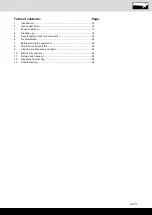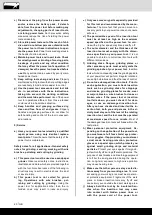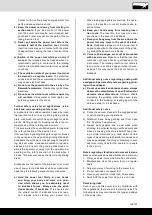
GB | 23
Brush edge
The grinding head of this power tool is enclosed by
a brush edge which offers the following two advan
-
tages:
a) The brush edge protrudes beyond the grinding
plate (1) and touches the surface to be processed
first. Thus, the grinding plate is positioned in par
-
allel to the working area before the insertion tool
comes in contact with the surface which is to be
processed. This is to prevent the formation of
sickle-shaped recesses caused by the grinding
disk edge.
b) Furthermore, the brush edge prevents the gen-
eration of excessive dust. Dust generated du ring
the grinding process is not transported towards
the outside but is removed by the extraction sys-
tem. Make sure before each operation with this
power tool that the brush edge is not damaged.
Have it replaced if there is damage or wear.
Connection to the power supply
1.
Make sure that the power tool is switched off. Al
-
ways switch the on/off switch (13) to off position
before connecting the power tool to the power
supply.
2. Plug the power plug into a correctly installed
socket which complies with the requirements
specified in the technical data.
3. Your power tool is now ready for operation.
Switching on/off
To switch on:
Push the on/ off switch (13)
Continuous operation: (fig. 9)
Secure the on/off switch (13) with the locking but
-
ton (6)
To switch off:
Press the on/off switch (13) briefly.
Adjusting the oscillation rate (fig. 8)
Before you start working, adjust the oscillation rate ac-
cording to the application. Use a low number of oscil-
lations for rough grinding, increase the oscillation rate
for fine work.
Adjust the oscillation rate by pressing the button (5).
• Press the button to increase the oscillation rate
(fig. 8).
• Press the button to decrease the oscillation rate
(fig. 8).
Note:
The insertion tool moves for a short while after
having it switched off. Do not put aside the power tool
until the insertion tool has come to a complete halt.
Sandpaper
Selection
1.
The grain size of the sandpaper is specified on
its rear side. The smaller the specified number,
the coarser the graining.
2. Use sandpaper with coarse grain for rough grind-
ing, and sandpaper with fine grain for finishing.
We recommend sandpapers with aluminium ox-
ide, silicon carbide or other synthetic abrasives.
3.
lf you can chose between sandpapers with differ
-
ent graining, you should start with coarse grain-
ing sandpaper and complete the grinding process
with the finest possible graining. Thus you will get
good and smooth grinding results.
How to apply and replace sandpaper
1. Apply the sandpaper (16) to the grinding plate (1)
using the Velcro strip mechanism.
2. Align the sandpaper (16) with the grinding plate
(1) and press it on evenly.
3.
PuII the sandpaper (16) off the grinding plate (1)
and replace it with a new one / another one (fig.
7).
Dust extraction
WARNING! Harmfull noxious gases may be gen-
erated when e.g. lead-containing paint is pro-
cessed. These gases entail a risk for the opera-
tor and the persons in the vicinity!
Therefore only use the power tool in combination
with a dust extraction unit, and protect yourself
and other persons in the working area with ad-
ditional suitable personal protective equipment!
When working with this power tool, a Iot of dust is
generated. The dust extraction unit is very useful if
you want to keep your workplace clean. lt is possi-
ble to combine the extraction system or a vacuum
cleaner with the extraction hose (14) which is con-
nected to the adapter for dust extraction.
Insert the hose adaptor (15) into the connection for
dust extraction (10 or 12) and lock it by twisting as
shown in fig. 5 and 6.
Note: Connect your tool to an extraction unit or vac-
uum cleaner. This will provide excellent extraction of
dust and debris.
m Attention! For health safety reasons it is imperative
that you use a dust extractor.
Note:
Make sure that the vacuum cleaner is suitable
for being used together with a power tool.
















































